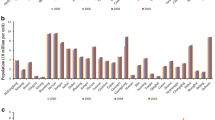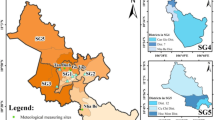Abstract
PM2.5 pollution used to be severe in China and the government has been devoted to PM2.5 control in recent years. Based on the latest multisource data and advanced algorithms, systematic environmental impact estimation of PM2.5 is achieved to demonstrate its trend and impacts under control policy. Policy validity is proved by a significant decrease in PM2.5 concentration (28%), energy intensity of GDP (13%), particulate matter emission (29%), and PM2.5 exceedance probability (51%) from the nation level. However, it still does not meet the requirement of WHO, and industrial and domestic sources are dominant for PM emission. The disaster risk index of air pollution is proposed to quantify and compare PM2.5 threat in 31 provinces, and risk gradually declines in 24 provinces except steady trend in Xinjiang, Shaanxi, Tianjin, Ningxia, Sichuan, Liaoning, and Tibet. Henan, Shanxi, Xinjiang, Hebei, Shaanxi, Tianjin, Ningxia, Jiangxi, Heilongjiang, and Anhui are identified as 10 high-risk regions with distinct driving factors. Current disease burdens attributable to PM2.5 exposure of provincial capitals in high-risk regions indicate huge health risks and economic losses. The heaviest health burden and economic burden are separately in Tianjin with 604,101 (95% CI: 302,796, 874,058) cases and 5.45% (95% CI: 2.73%, 7.89%) of population, and in Xi’an with 3122.24 (95% CI: 1398.55, 4274.53) million dollars and 2.31% (95% CI: 1.04%, 3.16%) of GDP. Results can provide references for worldwide PM2.5 control: scientific policy, treatment by the whole people and targeted control are crucial; it is urgent to arouse broad consensus on PM2.5 pollution and convert disease burden to health benefit.




Similar content being viewed by others
Data Availability
The datasets are downloaded from http://www.stats.gov.cn and http://www.mee.gov.cn.
References
Aubrecht C, Özceylan D (2013) Identification of heat risk patterns in the U.S. National Capital Region by integrating heat stress and related vulnerability. Environ Int 56:65–77. https://doi.org/10.1016/j.envint.2013.03.005
Crouse DL et al (2020) Evaluating the sensitivity of PM2.5–mortality associations to the spatial and temporal scale of exposure assessment. Epidemiology 31(2):168–176. https://doi.org/10.1097/EDE.0000000000001136
Dai F, Chen M, Yang B (2020) Spatiotemporal variations of PM2.5 concentration at the neighborhood level in five Chinese megacities. Atmospheric Pollution Research 11:190–202. https://doi.org/10.1016/j.apr.2020.03.010
El-Zein A, Tonmoy FN (2015) Assessment of vulnerability to climate change using a multi-criteria outranking approach with application to heat stress in Sydney. Ecol Indic 48:207–217. https://doi.org/10.1016/j.ecolind.2014.08.012
Fan J et al (2020) Joint pollution and source apportionment of PM2.5 among three different urban environments in Sichuan Basin, China. Sci Total Environ 714:136305. https://doi.org/10.1016/j.scitotenv.2019.136305
Gao P-P et al (2021) Contribution of PM2.5-Pb in atmospheric fallout to Pb accumulation in Chinese cabbage leaves via stomata. J Hazard Mater 407:124356. https://doi.org/10.1016/j.jhazmat.2020.124356
Greenpeace (2016) PM2.5 concentration ranking of 366 cities in China in 2015. Greenpeace. http://www.pm25.com/news/974.html. Accessed 1/3 2021
Gu K, Zhou Y, Sun H, Dong F, Zhao L (2020) Spatial distribution and determinants of PM2.5 in China’s cities: fresh evidence from IDW and GWR. Environ Monit Assess 193:15. https://doi.org/10.1007/s10661-020-08749-6
He Y, Huang X, Zhai L, Yan Q, Yang X (2016) Assessment and influencing factors of social vulnerability to rapid urbanization in urban fringe: A case study of Xi’an. Acta GeographicaSinica 71:1315–1328
IPCC (2014) IPCC AR5: Impacts, Adaptation, and Vulnerability. Cambridge University Press, United Kingdom
Jiang Y, Xing J, Wang S, Chang X, Liu S, Shi A, Liu B, Sahu SK (2020) Understand the local and regional contributions on air pollution from the view of human health impacts. Frontiers of Environmental Science & Engineering 15:88. https://doi.org/10.1007/s11783-020-1382-2
Li H, Li M (2018) Assessment on health benefit of air pollution control in Jiangsu province Chin J. Public Health 34:1631–1637
Li Y, Zhao X, Liao Q, Tao Y, Bai Y (2020) Specific differences and responses to reductions for premature mortality attributable to ambient PM2.5 in China. Sci Total Environ 742:140643. https://doi.org/10.1016/j.scitotenv.2020.140643
Li M et al (2021) Short-term exposure to ambient particulate matter and outpatient visits for respiratory diseases among children: A time-series study in five Chinese cities. Chemosphere 263:128214. https://doi.org/10.1016/j.chemosphere.2020.128214
Lu X, Chen Y, Huang Y, Lin C, Li Z, Fung JCH, Lau AKH (2019) Differences in concentration and source apportionment of PM2.5 between 2006 and 2015 over the PRD region in southern China. Sci Total Environ 673:708–718. https://doi.org/10.1016/j.scitotenv.2019.03.452
Maji KJ, Arora M, Dikshit AK (2017) Burden of disease attributed to ambient PM2.5 and PM10 exposure in 190 cities in China. Environ Sci Pollut Res 24:11559–11572. https://doi.org/10.1007/s11356-017-8575-7
Maji KJ, Ye W-F, Arora M, Shiva Nagendra SM (2018) PM2.5-related health and economic loss assessment for 338 Chinese cities. Environ Int 121:392–403. https://doi.org/10.1016/j.envint.2018.09.024
MEE (2013) Technical regulation for ambient air quality assessment (HJ 663-2013). Ministry of Ecology and Environment. China Environmental Science Press, Beijing
Mo X, Zhang L, Li H, Qu Z (2019) A novel air quality early-warning system based on artificial intelligence. Int J Environ Res Public Health 16. https://doi.org/10.3390/ijerph16193505
Mo X, Li H, Zhang L, Qu Z (2020) A novel air quality evaluation paradigm based on the fuzzy comprehensive theory. Appl Sci 10. https://doi.org/10.3390/app10238619
NASA (2015) Global haze map. National Aeronautics and Space Administration. https://www.chinanews.com/sh/2015/12-16/7674036.shtml. Accessed 1/3 2021
NBS (2020) China Statistical Yearbook 2020. China Statistics Press, Beijing, National Bureau of Statistics
NHC (2019) Technical specifications for health risk assessment of ambient air pollution (WS/T 666-2019). National Health Commission. http://www.nhc.gov.cn/fzs/s7848/201907/3baff64579a54d5585923a272dfcbcf2/files/1aa74d289811437e9f507fb101206849.pdf. Accessed 1/3 2021
NHC (2020) China Health Statistics Yearbook 2020. China Union Medical University Press, Beijing, National Health Commission
Sepehri M, Malekinezhad H, Hosseini SZ, Ildoromi AR (2019) Assessment of flood hazard mapping in urban areas using entropy weighting method: a case study in Hamadan city. Iran Acta Geophysica 67:1435–1449. https://doi.org/10.1007/s11600-019-00342-x
Sun S et al (2020) Air pollution associated respiratory mortality risk alleviated by residential greenness in the Chinese Elderly Health Service Cohort. Environ Res 183:109139. https://doi.org/10.1016/j.envres.2020.109139
UNEP (2021) International Day of Clean Air for blue skied. United Nations Environment Programme. https://www.unep.org/interactive/all-you-need-to-know-air-pollution/ch/ch/ch/. Accessed 1/3 2021
Wang G, Wu L, Chen J, Song Y, Rongrong C (2017) A CGE-based analysis on PM2.5-induced health-related economic effect in Beijing. China Environ Sci 37:2779–2785
Wang J, Zhang L, Niu X, Liu Z (2020a) Effects of PM2.5 on health and economic loss: evidence from Beijing-Tianjin-Hebei region of China. J Clean Prod 257:120605. https://doi.org/10.1016/j.jclepro.2020.120605
Wang L, Deng J, Yang L, Yao Y, Xu D (2020b) Analysis of the spatial patterns of particulate pollution in the persistent haze in Northeast China: a case study in Harbin City. Nat Environ Pollut Technol 19:865–871. https://doi.org/10.46488/NEPT.2020.v19i02.046
Wei A, Li D, Dai F, Lang X, Ma B, Wang Y (2021) An optimization method coupled the index-overlay method with entropy weighting model to assess seawater intrusion vulnerability. Environ Sci Pollut Res. https://doi.org/10.1007/s11356-021-13229-6
WHO (2021) Health topics: air pollution. World Health Organization. https://www.who.int/topics/air_pollution/zh/. Accessed 1/3 2021
Xie Z, Qin Y, Li Y, Shen W (2017) Evaluation of haze press risk in China based on PM2.5. Acta Sci Circumst 37:4303–4510
Xie Y, Dai H, Zhang Y, Wu Y, Hanaoka T, Masui T (2019) Comparison of health and economic impacts of PM2.5 and ozone pollution in China. Environ Int 130:104881. https://doi.org/10.1016/j.envint.2019.05.075
Xu X, Zhang W, Zhu C, Li J, Yuan W, Lv J (2021) Regional sources and the economic cost assessment of PM2.5 in Ji’nan, eastern China. Atmospheric Pollution Research 12:386–394. https://doi.org/10.1016/j.apr.2020.11.019
Yao M, Wu G, Zhao X, Zhang J (2020) Estimating health burden and economic loss attributable to short-term exposure to multiple air pollutants in China. Environ Res 183:109184. https://doi.org/10.1016/j.envres.2020.109184
Yue H, He C, Huang Q, Yin D, Bryan BA (2020) Stronger policy required to substantially reduce deaths from PM2.5 pollution in China. Nat Commun 11:1462. https://doi.org/10.1038/s41467-020-15319-4
Zhang Q et al (2021) Spatial distribution and sources of winter black carbon and brown carbon in six Chinese megacities. Sci Total Environ 762:143075. https://doi.org/10.1016/j.scitotenv.2020.143075
Funding
This research was funded by the National Natural Science Foundation of China (41521004) and the Second Tibetan Plateau Scientific Expedition and Research Program (STEP, Grant No. 2019QZKK0602).
Author information
Authors and Affiliations
Contributions
Conceptualization, Xinyue Mo and Huan Li; methodology, Xinyue Mo and Huan Li; software, Xinyue Mo and Huan Li; validation, Xinyue Mo and Huan Li; data curation, Xinyue Mo and Huan Li; writing—original draft preparation, Xinyue Mo and Huan Li; writing—review and editing, Xinyue Mo, Huan Li, Lei Zhang, and Zongxi Qu; supervision, Lei Zhang; project administration, Lei Zhang; funding acquisition, Lei Zhang. All authors have read and agreed to the published version of the manuscript.
Corresponding author
Ethics declarations
Conflicts of Interest
The authors declare no competing interests.
Additional information
Publisher’s note
Springer Nature remains neutral with regard to jurisdictional claims in published maps and institutional affiliations.
Xinyue Mo and Huan Li are co-first authors.
Appendix
Appendix
Rights and permissions
About this article
Cite this article
Mo, X., Li, H., Zhang, L. et al. Environmental impact estimation of PM2.5 in representative regions of China from 2015 to 2019: policy validity, disaster threat, health risk, and economic loss. Air Qual Atmos Health 14, 1571–1585 (2021). https://doi.org/10.1007/s11869-021-01040-8
Received:
Accepted:
Published:
Issue Date:
DOI: https://doi.org/10.1007/s11869-021-01040-8




